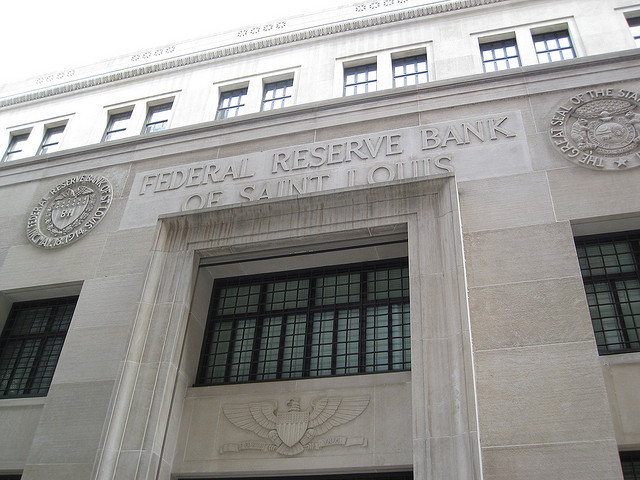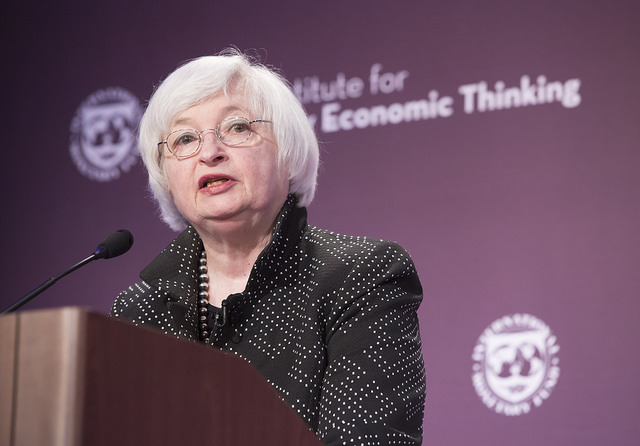 The Fed announced the interest rate increase at its Dec. 15-16 meeting.
The Fed announced the interest rate increase at its Dec. 15-16 meeting.
Photo Credit: Chris Yunker via Flickr cc
After an extraordinarily long period of time of historically-low interest rates and countless meetings promising an interest hike, the Fed finally inched the federal funds rate up.
After its much-anticipated meeting on December 15 and 16, the Fed cut the suspense by announcing that it would be
raising its target interest rate by a quarter of a percentage point. This marks an event that policy makers, investors and bankers have been waiting a very long time for. Ever since the economic debacle of 2008, the Fed has kept a lid on interest rates in an effort to dig the economy out of a deep hole.
The last time they raised rates was back in 2006, so this event is certainly making headline news in the financial world
Despite this promise, short-term rates will not skyrocket overnight - instead, interest rates are said to be raised by
approximately one percent annually over the next three years. Such a gradual increase in rates will depend on the continued growth of the US economy. The Fed obviously wants to judiciously expand and improve the American economy. It seeks to increase rates to hedge against potential higher inflation or future economic troubles, yet slowly enough so as to not risk sabotaging the current economic recovery.
Interest rates on mortgages and other types of loans will most likely stay on the low end of the historical scale for a little while still.
Consumers have been benefiting from low interest rates over the past seven years or so, and won't exactly feel the effects of an increase in rates so deeply. Any increased yields on savings will barely be felt right off the bat, and the cost of borrowing will only slightly increase. Fed chairwoman Janet L. Yellen has always been highly conservative in her approach to rising interest rates, and nothing's changed with her politics today.
 Fed chairwoman Janet L. Yellen has always been on the conservative end, which explains the slow-but-steady increase rate.
Fed chairwoman Janet L. Yellen has always been on the conservative end, which explains the slow-but-steady increase rate.
Photo Credit: International Monetary Fund via Flickr cc
Of course, the financial industry is thrilled with this announcement. While low interest rates brought about reduced borrowing costs for banks, it has also limited what these financial institutions can charge on loans and earn on investments. The spread between these two has been dropping over the past five years, and such a sustained low-interest environment has been negatively affecting revenue and earnings for banks all across the country.
For this reason, higher interest rates have been on the wish list of US banks, particularly small- to mid-sized entities. When interest rates rise, lenders can then raise the amount they charge for loans faster than what they must pay on deposits.
The basic business model of America's banks is a simple one: take deposits and generate loans. Smaller community banks, in particular, depend largely on the revenues generated from loans, so a sustained low interest rate environment had been nothing short of costly for these smaller-scale financial institutions. This business model hasn't been particularly successful since 2008, with profits eroding among many of America's community banks.
But with news about an interest rate increase, community banks can breathe a small sigh of relief. While the numbers aren't spiking, they're still headed in the right direction. It's a sign of a potential boost in the US economy, which has been long-awaited in the banking markets.
What Does this Recent Announcement Mean For Banks?
As interest rates continue to rise, the profitability of bank loans will also increase, as there is a
wider spread between the Fed's rate and what rate the banks charge its clients. Under these conditions, the odds of banks making profitable loans are much better.
With an increase in interest rates also comes an expanded spread between long-term and short-term rates, as long-term rates have a tendency to increase at a faster pace. Since banks loan out funds on a long-term basis and borrow on the short-term, this is an ideal environment for them.
Market interest rates and the price for fixed-rate instruments typically move in opposite directions. As interest rates start to increase, the prices of fixed-rate instruments go down in value. In this environment, banks should continue to focus on purchasing short-term or adjustable rate loans to add to their loan portfolios.
To ensure this endeavor is an effective one, banks should consider collaborating with a financial services and loan valuation partner. At Garnet Capital, we can assist your financial institution in unveiling areas of heightened opportunity in terms of acquiring loan portfolios. With our in-depth experience, we can offer great insight into acquiring the right short-term or adjustable rate loans for your portfolio.
For more information about loan portfolio acquisitions,
sign up for our newsletter today.






